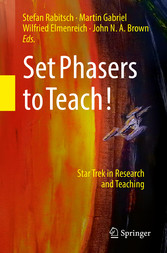Suche
Lesesoftware
Info / Kontakt
Set Phasers to Teach! - Star Trek in Research and Teaching
von: Stefan Rabitsch, Martin Gabriel, Wilfried Elmenreich, John N.A. Brown
Springer-Verlag, 2018
ISBN: 9783319737768 , 242 Seiten
Format: PDF, Online Lesen
Kopierschutz: Wasserzeichen




Preis: 42,79 EUR
eBook anfordern 
Preface: “Engage!” Science Fiction and Science Inspire Each Other and Move Society Forward
7
“With A Wondrous Leap of the Imagination”: Star Trek as Beacon and Compass
9
Works Cited
12
Contents
13
“Where Many Books Have Gone Before”: Using Star Trek to Teach Literature
17
“Strange New Worlds”: The Value of Intertextual Understanding
19
“Ahab has to Hunt his Whale!”: Star Trek as a Tool to Teach Specific Texts
20
“No more metaphors, Bones. That’s an order”: Learning Literary Concepts and Techniques Through Star Trek
23
“Something Spock was trying to tell me on my birthday”: Literary Themes in Star Trek
25
“You’ll find it in all the literature of the period”: Literature as Pleasure
26
Works Cited
27
From ‘Shalom Aleichem’ to ‘Live Long and Prosper’: Engaging with Post-war American Jewish Identity via Star Trek: The Original Series
28
The Uses of Jewish Studies and Star Trek
30
A Transitional Moment for American Jews
32
Jewish Bodies, Jewish Characters?
33
Beyond Embodiment: Jewish Stories in Star Trek
37
Boldly Going Further: Towards Future Work On Star Trek and Jewish Studies
40
Works Cited
41
Recommended Reading
42
“Wagon Wheels, Sails, and Warp Cores”: Star Trek and American Culture: Between Allegory and Worldbuilding
43
Introduction – Recognizing the Known Unknown
45
What If? – The Workings of sf
47
Allegory – Westerns, Kennedy and the New Frontier of the 1960s
49
Worldbuilding – Pax Transatlantica, or the Best of Both Worlds
51
Conclusion – Continuing Voyages
53
Works Cited
54
Recommended Reading
55
How to Name a Starship: Starfleet between Anglo-American Bias and the Ideals of Humanism
56
Works Cited
63
The Computer of the Twenty-Third Century: Real-World HCI Based on Star Trek
64
“It’s interaction, Jim, but not interaction as we know it.”
66
“The helm is not responding, Captain. Permission to turn it off and on again?”
67
“I can nae get the power, Captain. She’s configuring her updates!”
67
“Siri, where are the nuclear vessels?” “I’m sorry, I do not understand: ‘Fear art. See new, clear weasels’.”
68
“Captain, I cannot raise the incoming craft. It is using an incompatible interface and an out of date codex.”
69
“Dammit Jim, I’m a doctor not a search engine!”
70
“Sir, the ensigns are refusing to wear red shirts and threatening to dox anyone who sends them on an away mission.”
70
“Scanning the planet’s surface for Snarks, Captain, but detecting only Boojums.”
71
An Upgrade from the Technicians of Cygnet-14
72
Boldly Going Where No One Has Gone Before, in Order to Make It Accessible to Everyone
73
References
74
The Energy System in Star Trek and Its Real-Life Counterparts
75
The Use, the Need, and the History of Energy
77
Energy in Star Trek
77
Energy Production and Consumption Through the Lens of Star Trek
80
Works Cited
81
“My People once lived in Caves”: Pre-modern Societies in Star Trek
83
Introduction – “[O]n its way to rendezvous with history”
85
Pre-modern, Modern, Postmodern – Where Do Historians Draw the Line(s)?
86
Pre-modern Societies in Star Trek – “It was my first visit to a pre-warp culture”
88
Conclusion – “I don’t know who writes your history books”
91
Works Cited
92
“Ready To Beam Up”: Star Trek and its Interactions with Science, Research and Technology
94
Science, Research and Popular Culture
96
Star Trek as a Fictional Laboratory
97
Star Trek and the Public Communication of Science and Technology
97
Star Trek as Inspiration for Innovation and Technology
98
Positive Role-Models Provided by Star Trek
99
Making Friends: Star Trek and NASA
100
Conclusion
102
Works Cited
103
“Teaching with Trek”: Star Trek, the LGBTQ+ Community, and College Composition
105
Works Cited
114
“Resistance is Futile”: Using the Borg to Teach Collective Computing Systems
116
Introducing the Borg
118
The Borg, Their Traits, and Computer Science
119
Self-Aware Systems
119
Collectives
120
Benefits of the Borg and Collectives
121
Conclusion
122
Works Cited
123
Telepathic Pathology in Star Trek
125
Introduction
127
Mass Effects
128
Single Effects
129
Conclusions
130
Works Cited
132
Playing Captain Kirk: Designing a Video Game Based on Star Trek
133
Introduction
135
Why Is That?
135
What Would It Take to Get There?
136
Star Trek & Successful Games
136
Cornerstones of Good Games
138
Meaningful Choices
138
Immersion and Identification
138
Challenging Resource Management
139
Progression and Achievement
139
Pros and Cons for a Game Set in the Star Trek Universe
140
Boldly Going
141
A Proposal: Seeking Out New Life and New Civilizations
142
Conclusion
143
Works Cited
143
To Seek Out New Forms of Knowledge: Viewing Star Trek as an Introduction to Cognitive Science and Ways of Thinking About Narrative, Theory of Mind, and Difference
144
Introduction
146
Theory of Mind and Empathy
147
Look, a Mirror Mechanism
147
Star Trek + POP CULTURE = POWER/POLITICS
148
Star Trek and Empathy
149
Empathy, Metaphor, and Star Trek
151
An Emerging Lesson Plan, a Possible Assignment
152
Works Cited
153
La Forge’s VISOR and the Pictures in Our Heads: Understanding Media Studies Through Star Trek
155
Introduction
157
“A Fly on the Wall”
158
“What’s normal?”
160
“Special Insight”
162
Conclusion
164
Works Cited
165
Recommended Reading
166
“Logic is the beginning of wisdom … not the end”: Using Star Trek to Teach Scientific Thinking
167
Works Cited
177
Appendices
179
Appendix 1
179
Appendix 2
184
Appendix 3
185
Appendix 4
201
Appendix 5
215
Appendix 6
231
Appendix 7
239
Appendix 8
240





